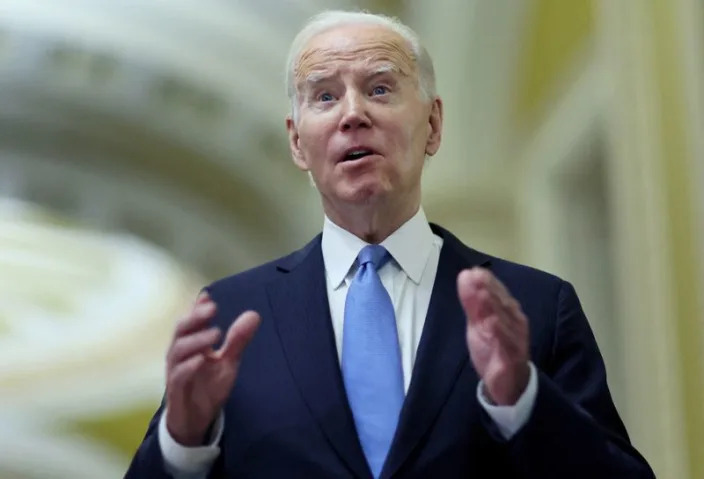Editor OilPrice.com
Wed, March 8, 2023
A few years ago, carbon capture was an eccentric, massively expensive way of reducing emissions, or so the talking point went. By 2022, carbon capture had in fact become one of the few ways in which oil companies could defend themselves against the onslaught of accusations of being the sole perpetrators of climate change. And then the Biden administration decided to support that.
For many environmentalists, the participation of the oil and gas industry in the transition is not simply impossible because of the very nature of the business but also very much unwanted. The only way oil and gas can take part in the transition, according to these activists who block traffic and vandalize works of art across Europe, is if the industry ceases to exist. Apparently, the Biden administration's opinion differs.
The Inflation Reduction Act is a piece of legislation that quickly became the target of as much praise as criticism for its generosity in funding low-carbon technologies and infrastructure. It is the biggest piece of legislation aimed at addressing climate change, stipulating spending of $369 billion in total.
Some of that money will likely go to oil companies to develop more carbon capture capacity, retrofit refineries to produce biofuels, and pursue the dream of cheap and clean hydrogen.
This week at CERAWeek, Chevron and Talos Energy said they were going to make their planned carbon capture and storage hub in Texas three times as large as originally intended.
"The market is huge," Chevron's vice president for carbon capture, utilization, and storage, Chris Powers, told media, as quoted by Reuters. "In order to meet the ambitions of the Paris Agreement, we are going to do CCUS at massive scale, with multiple hubs like this."
Exxon's Darren Woods echoed the sentiment last month. Speaking to investors, the chief executive of Exxon said, "There's a lot of activity in this space [carbon capture], a lot of interest, particularly with the IRA. I think we're very well positioned there," he said.
"This is not a game for start-ups. These are large, world-scale projects that require the kind of project expertise that we have, require the kind of size and balance sheet capacity that we have," Woods also noted.
Indeed, carbon capture and storage—or utilization—projects are large-scale undertakings that cost a lot of money, even though they are not as massively expensive as their opponents allege them to be. If the federal government wants to share some of that burden, the companies already active in this space would only be too happy to get the help.
According to the International Energy Agency, the transition to net zero would be impossible without carbon capture and related activities, be they reuse or storage. And it would need to be deployed on a huge scale, globally.
"The scale of the climate challenge means we need to act across a wide range of energy technologies. Carbon capture is critical for ensuring our transitions to clean energy are secure and sustainable," the IEA's Fatih Birol said at the release of the report three years ago.
This is why the IRA subsidy stipulations include carbon capture—because it appears to be critical for the transition. Yet opposition against it remains loud. More than a hundred groups earlier this month urged Congress to drop plans to provide further, targeted support to carbon utilization projects in the form of tax credits.
"This bill does not advance climate solutions, but is rather a giveaway to fossil fuel companies and other corporate polluters under the guise of climate action," the group wrote in a letter to the sponsors of the legislation, as quoted by Common Dreams.
"Promoting the utilization of captured CO2 in petrochemicals, plastics, and fuels, as your legislation would encourage, will perpetuate environmental justice harms and subsidize the oil and gas industry to do it."
According to the chief sponsor of the bill, Senator Sheldon Whitehouse, the bill would simply expand eligibility for tax credits to cover not only those active in sequestration but in the utilization of carbon dioxide.
"Our bipartisan Carbon Capture and Utilization Parity Act would bring the value of the tax credits for carbon utilization in line with the incentives for sequestration, while supporting continued investment in carbon-neutral products," he said on his webpage.
There are plenty of uses for carbon dioxide—from making soft drinks and beer fizzy to producing synthetic, low-carbon fuels. One could go as far as to say carbon dioxide is an indispensable commodity for a range of industries just as it is indispensable for plant life—and, consequently, all life—on Earth.
Of course, carbon dioxide can - and routinely is - injected back into oil wells to stimulate production, and this appears to be the focus of the opposition against CCUS technology as a whole, because it is used to produce even more oil and gas when we should be producing less.
Yet the tide is changing in the oil and gas rhetoric. Big Oil executives have recently made statements they would hardly have dared make just two years ago. BP's and Shell's chief executives said on separate but recent occasions that oil and gas production remains necessary and will likely remain so over the long term, despite the transition to net zero.
Their counterparts in the United States, normally bolder when it comes to the essential nature of their products, have remained bold, especially amid calls from the federal government for more oil and gas production. And now both American and European supermajors plan to take advantage of the IRA billions, just like wind and solar developers and EV makers.
By Irina Slav for Oilprice.com
US Energy Regains Its Swagger While Rest of World Gets IRA Envy


Jennifer Granholm
Kevin Crowley and Jennifer A. Dlouhy
Wed, March 8, 2023
(Bloomberg) -- Energy executives and Biden administration officials in Houston had a simple message for Europe and other regions griping that US climate spending will starve them of investment: Stop complaining and put up the cash to enact measures of your own
In a standing-room-only luncheon address at the CERAWeek by S&P Global conference, Energy Secretary Jennifer Granholm boasted the newly enacted infrastructure law and Inflation Reduction Act have made the US “irresistible” for clean energy investments. The more than $360 billion in support for clean energy and advanced manufacturing — as well as preferences for domestic content — have provoked tensions with allies including the European Union
There’s nothing wrong with “a little friendly competition,” she said. “As we keep saying, have at it. You should do the same thing. You should incentivize the production of clean energy in your country as well.”
Democratic President Joe Biden’s signature climate and infrastructure laws received almost universal praise from the world’s top fossil fuel executives at the conference, as they struck a more confident tone than in years gone by.
A year of energy shortages, volatile prices and recalibrating the global supply chain following Russia’s invasion of Ukraine has underscored the enduring importance of oil and gas, even as the world attempts to transition to cleaner fuels.
The billions of dollars of fiscal incentives baked into the IRA mean the world’s biggest energy and industrial companies now view the US as the most attractive place to build renewable, carbon capture, and hydrogen facilities. That’s a problem for allies in Europe, Canada and elsewhere who are now playing catch-up to attract the capital for large-scale clean-energy projects.
“My speech to European leaders is: Don’t complain, do the same,” said Patrick Pouyanne, Chief Executive Officer of Paris-based TotalEnergies SE. The IRA is “exactly what we need to do” to accelerate the energy transition. “We say to European governments, since you want us to invest in Europe, you have to put the same incentive schemes as the US, or even more.”
Exxon Mobil Corp. CEO Darren Woods said the EU first needs to scrap a “punishing” windfall profits tax on oil companies that will wipe out years of profits from recent investments in its European refineries. As a result, the Texas oil giant has “stepped back and reevaluated” in Europe and is investing more in the US, he said.
EU leaders appear concerned. The war in Ukraine and the withdrawal of Russian gas have supercharged the continent’s push toward clean energy but the long-term strategy could be under threat with companies like Tesla Inc. and Volkswagen AG now prioritizing investment in the US. “Europe’s competitiveness and resilience is in danger,” the EU’s internal market authority said in an initial assessment seen by Bloomberg.
A clean energy arms race would be welcome, said Meghan Nutting, executive vice president of government and regulatory affairs at Sunnova Energy International Inc.
“For years, Europe was asking us to do something to meet the Paris climate agreement requirements, and we finally did, and now they’re worried we’re doing that,” she said on a panel Monday.
It’s not just the sheer size of the IRA that has won the backing of energy leaders, but also its simplicity. Big and small companies alike can access funds, and projects don’t have to wait years to redeem tax credits. Crucially, the legislation comes with few punitive measures that affect the industry’s cash cow, oil and gas.
The IRA is “all carrots, no sticks,” Alex Pourbaix, CEO of Cenovus Energy, said in an interview, picking up a metaphor that’s become ubiquitous at the conference. Pourbaix called on Canada to adopt similar legislation, which he says would accelerate the decarbonization of the country’s oil sands. Australian and Japanese executives also expressed admiration for the IRA.
“If we don’t we’re just going to see that capital flee the country and go to the US,” Pourbaix said.
The full-throated praise for the IRA marked a sharp contrast with recent sniping between oil executives and Biden, who has criticized them for not investing more in production and instead funneling profits into share buybacks.
In Houston, both sides seemed content to accentuate the positive. White House climate adviser John Podesta, a vocal climate hawk, used an appearance at the event to announce new plans to reduce permitting time on major projects, a major concern for energy producers.
Granholm’s rousing address also was well-received, a sharp contrast to her speech last year at the event, when she implored the gathered executives to do more to step up production in the face of energy shortages stemming from Russia’s war with Ukraine.
This time, Granholm stressed that the oil industry can bring its know-how to US investments in clean energy development that will yield worldwide benefits — including lower costs — far beyond American borders.
“We make no apologies for the level of investments that are happening,” Granholm said. “We don’t want to stoke trade wars or anything like that, but we are serious about bringing back supply chains into this country.”


Jennifer Granholm
Kevin Crowley and Jennifer A. Dlouhy
Wed, March 8, 2023
(Bloomberg) -- Energy executives and Biden administration officials in Houston had a simple message for Europe and other regions griping that US climate spending will starve them of investment: Stop complaining and put up the cash to enact measures of your own
In a standing-room-only luncheon address at the CERAWeek by S&P Global conference, Energy Secretary Jennifer Granholm boasted the newly enacted infrastructure law and Inflation Reduction Act have made the US “irresistible” for clean energy investments. The more than $360 billion in support for clean energy and advanced manufacturing — as well as preferences for domestic content — have provoked tensions with allies including the European Union
There’s nothing wrong with “a little friendly competition,” she said. “As we keep saying, have at it. You should do the same thing. You should incentivize the production of clean energy in your country as well.”
Democratic President Joe Biden’s signature climate and infrastructure laws received almost universal praise from the world’s top fossil fuel executives at the conference, as they struck a more confident tone than in years gone by.
A year of energy shortages, volatile prices and recalibrating the global supply chain following Russia’s invasion of Ukraine has underscored the enduring importance of oil and gas, even as the world attempts to transition to cleaner fuels.
The billions of dollars of fiscal incentives baked into the IRA mean the world’s biggest energy and industrial companies now view the US as the most attractive place to build renewable, carbon capture, and hydrogen facilities. That’s a problem for allies in Europe, Canada and elsewhere who are now playing catch-up to attract the capital for large-scale clean-energy projects.
“My speech to European leaders is: Don’t complain, do the same,” said Patrick Pouyanne, Chief Executive Officer of Paris-based TotalEnergies SE. The IRA is “exactly what we need to do” to accelerate the energy transition. “We say to European governments, since you want us to invest in Europe, you have to put the same incentive schemes as the US, or even more.”
Exxon Mobil Corp. CEO Darren Woods said the EU first needs to scrap a “punishing” windfall profits tax on oil companies that will wipe out years of profits from recent investments in its European refineries. As a result, the Texas oil giant has “stepped back and reevaluated” in Europe and is investing more in the US, he said.
EU leaders appear concerned. The war in Ukraine and the withdrawal of Russian gas have supercharged the continent’s push toward clean energy but the long-term strategy could be under threat with companies like Tesla Inc. and Volkswagen AG now prioritizing investment in the US. “Europe’s competitiveness and resilience is in danger,” the EU’s internal market authority said in an initial assessment seen by Bloomberg.
A clean energy arms race would be welcome, said Meghan Nutting, executive vice president of government and regulatory affairs at Sunnova Energy International Inc.
“For years, Europe was asking us to do something to meet the Paris climate agreement requirements, and we finally did, and now they’re worried we’re doing that,” she said on a panel Monday.
It’s not just the sheer size of the IRA that has won the backing of energy leaders, but also its simplicity. Big and small companies alike can access funds, and projects don’t have to wait years to redeem tax credits. Crucially, the legislation comes with few punitive measures that affect the industry’s cash cow, oil and gas.
The IRA is “all carrots, no sticks,” Alex Pourbaix, CEO of Cenovus Energy, said in an interview, picking up a metaphor that’s become ubiquitous at the conference. Pourbaix called on Canada to adopt similar legislation, which he says would accelerate the decarbonization of the country’s oil sands. Australian and Japanese executives also expressed admiration for the IRA.
“If we don’t we’re just going to see that capital flee the country and go to the US,” Pourbaix said.
The full-throated praise for the IRA marked a sharp contrast with recent sniping between oil executives and Biden, who has criticized them for not investing more in production and instead funneling profits into share buybacks.
In Houston, both sides seemed content to accentuate the positive. White House climate adviser John Podesta, a vocal climate hawk, used an appearance at the event to announce new plans to reduce permitting time on major projects, a major concern for energy producers.
Granholm’s rousing address also was well-received, a sharp contrast to her speech last year at the event, when she implored the gathered executives to do more to step up production in the face of energy shortages stemming from Russia’s war with Ukraine.
This time, Granholm stressed that the oil industry can bring its know-how to US investments in clean energy development that will yield worldwide benefits — including lower costs — far beyond American borders.
“We make no apologies for the level of investments that are happening,” Granholm said. “We don’t want to stoke trade wars or anything like that, but we are serious about bringing back supply chains into this country.”










.jpg)



